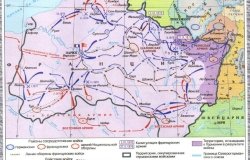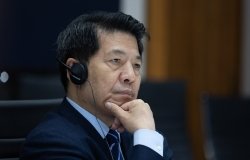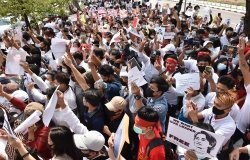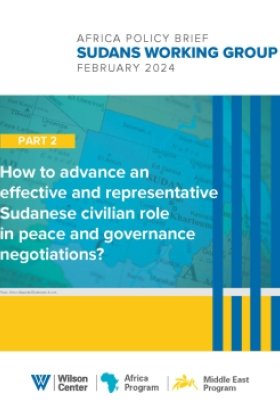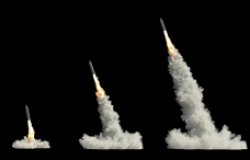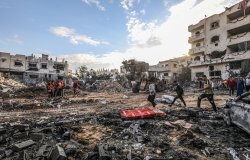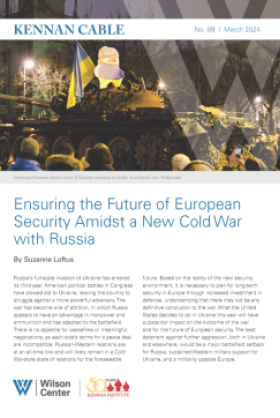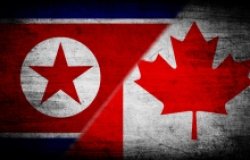War and Politics in Libya, Yemen, and Syria
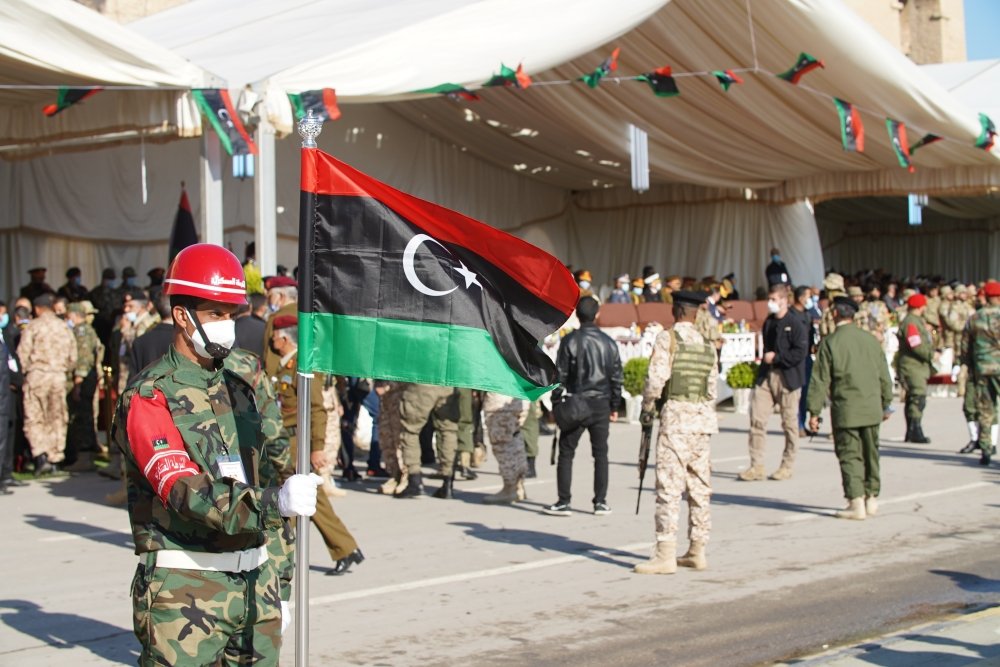
Hussein Eddeb / shutterstock.com
The problem is that politics requires the presence of political parties, rather than of armed groups, but such political parties do not exist in a meaningful form.
In Libya, Syria and Yemen, the 2011 uprisings led almost immediately to armed conflict. Civilian protesters, largely peaceful, were quickly sidelined as were most of the old political parties, where they existed. Politics, in the sense of unarmed competition among different groups, took second place to fighting on the ground, although in Syria the formal political process continued to unfold amidst war and devastation. But in the solutions that international organizations and intervening countries are proposing to end these conflicts put politics center stage, with elections the key to the transition. The problem is that politics requires the presence of political parties, rather than of armed groups, but such political parties do not exist in a meaningful form. The tragedy for these three countries is that they are caught in a paradoxical situation: the outright victory of one side is extremely unlikely, requiring a political solution, but the elements necessary to make a political solution work do not appear to exist at this point. Syria is the possible exception in that the regime of Bashar al-Assad has gone farther than those in the other two countries in re-establishing control.
Functioning political parties are necessary to the implementation of all proposed political solutions. While there is no doubt that parties will spring up in astonishing numbers when elections are called and the rules for registering parties announced—this is what always happens--there are reasons to doubt the effectiveness of such hastily organized groups and the possibility they will wean the countries away from conflict.
Although all three countries share a history of quick transitions from political to armed struggle, followed by an attempt to claw their way back to politics, they are quite different in most respects. Yemen is the poorest of the three countries and it has always been ruled by authoritarian regimes, separately in northern and southern Yemen and jointly after 1990. Yet, the country has also had an active political life with political parties that have survived a decade of conflict and will most probably have a role in a future political settlement.
Syria, with a more sophisticated economy and much better educated population, and even some experience with democracy in the 1920s, has had a less active political life in recent decades. Its regimes, particularly under the Assad dynasty, have not necessarily been more authoritarian than those of the other countries under discussion, but they have been more efficient at enforcing control and limiting the space where other groups could survive. Political organizations are less well-established than in Yemen, are clearly subordinated to the regime, and thus are less likely to break the authoritarianism of the regime in the future.
Libya is the most difficult country to characterize. It is relatively wealthy when it manages to maintain enough order to extract oil and bring it to market, but the rest of the economy is extremely underdeveloped and its population poorly educated. Furthermore, it had virtually no experience of political life during the four decades under the rule of Muammar Gaddafi (1969-2011), so it will have to reinvent politics, not just restore it, in order to implement a political settlement. The United Nations’ valiant efforts to devise a way forward for the embattled country have resulted in prescribing a process that meshes poorly with the reality on the ground.
Libya
Libya entered its transition crisis in a situation devoid of normal politics, that is of unarmed competition tempered by rules. Ten years later, it still has not been able to generate a meaningful political process, although the United Nations was trying to superimpose one that disregarded the real situation.
Like all dictators, Muammar Gaddafi sought to eliminated independent organizations that could limit his power. Unlike most modern dictators, who increasingly maintain a political facade of democratic processes while making sure that their own power remains unchallenged, he was quite open about his rejection of normal politics and had created a new political system supposedly based on direct control by citizens. Few could understand it: searching for clarity, I once talked to a political attaché at the Libyan Embassy in Canada (the US had no diplomatic relations with Libya at the time) who cheerfully admitted he could not help me because he did not have the slightest idea how the system was supposed to work. But political parties, not even a government controlled single party, were certainly not part Gaddafi’s vision.
The absence of political organization did not prevent anti-Gaddafi demonstrations from erupting in Benghazi on February 15, 2011, as was happening all over the Arab region. Civilian protest was superseded in a matter of days by armed combat between elements of the military that remained loyal to Gaddafi and those that joined the protesters and their militias. The chaos led to intervention by NATO countries authorized by UN Security Council resolution 1973. The intervention set Gaddafi and his family on the run and led to the capture and killing of Colonel Gaddafi himself in October. At this point, NATO involvement came to an end. No country, least of all the United States, had an appetite for another open-ended commitment as in Afghanistan and Iraq, so Libya was left to find solutions on its own.
Neither was the executive; rather, power was extremely decentralized in the hands of towns and tribes and their militias, well-armed from the abandoned weapons caches left all over the country by the Gaddafi regime.
The first Libyan attempt to stand up a civilian government faltered. The National Transitional Council, established in March 2011, could not govern until Gaddafi was defeated and struggled in the following months. In July 2012, it held elections for a parliament, the General National Congress. Some 374 parties were hastily organized before the elections, but only two succeeded in winning more than three seats: the centrist National Forces Alliance (including some 50 groups) won 39 seats, and the Justice and Construction Party, affiliated with the Moslem Brotherhood won 17. With 120 seats reserved for independents, the parliament did not represent organized constituencies. Not surprisingly, it was never the real seat of power. Neither was the executive; rather, power was extremely decentralized in the hands of towns and tribes and their militias, well-armed from the abandoned weapons caches left all over the country by the Gaddafi regime.
The General National Congress was tasked with writing the constitution, but had made little progress when its mandate expired in 2014, thus leaving the government with no guidelines. The GNC announced it would not step aside, but in June the Transitional Council held elections for the new House of Representatives, with only 18 percent of voters participating and all candidates running as independents.
What happened next is best described as anarchy. The newly elected House of Representatives left Tripoli when it was overrun by Islamist militias and settled in Tobruk in the East. In response, the General National Congress resurrected itself and continued to work from Tripoli. The country thus had two competing parliaments. The executive was equally split, with a government chosen by the House of Representatives and recognized internationally, and a second one tied to the General National Congress. To make matters worse, the Libyan military was equally divided, with a Libyan National Army de facto controlled by General Khalifa Haftar in the East and a Libyan Army close to the General National Council in Tripoli. Both so called armies also had a large component of semi-independent militias, although the Libyan National army under General Haftar was probably better organized. Haftar, a former associate of President Gaddafi later exiled in Washington and plotting against Gaddafi from there, was more than a military commander: he had clear aspirations to become Libya’s next ruler.
In this unpromising situation, the United Nations representative bravely stepped in, attempting to negotiate a way forward with the rival factions. He managed, over a period of months, to get the two parliament and the rival governments to agree to the formation of a Government of National Accord and accept the authority of the House of Representatives while the General National Congress would set up instead an advisory body, the High Council of State. The tottering edifice would be topped by a nine-member presidential council. After prolonged negotiations, in December 2015 all groups appeared to accept the Libyan Political Agreement.
Implementation faltered. The High Council of State was formed, but a rival one also emerged. The agreed upon Government of National Accord was established but did not receive unanimous recognition. An additional blow came in December 2017 when General Haftar declared the agreement null and void.
About one year later, General Haftar tried to settle the problem of power militarily. In April 2019, he launched an offensive on Tripoli, which eventually failed, but only after prolonged fighting that saw intervention of militias on all sides. In October 2020, Haftar finally admitted that he was not going to be able to occupy Tripoli and agreed to a ceasefire agreement, which opened the way for a renewed United Nations effort to revive the political agreement.
At the time of this writing one year after the ceasefire, some progress had been made. First, the Government of National Unity was finally set up in March 2021 and gained a confidence vote from the two rival parliaments meeting in joint session. The two military coalitions agreed to work with the new government and with the Presidency Council, reduced from nine to three members. Finally, all sides agreed to hold elections in December 2021. Yet the fragility of the progress was underlined by the fact that elections were cancelled at the last moment for fear that the rivalry among candidates would lead to a renewal of fighting. The country is still awash in rival armed factions and militias, and there is still no agreement on the future command structure of the military. General Haftar still retains control of the military forces in the East, although he announced in September that he would put somebody else in control for three months, until the day of elections, in order to run for president.
At the very least, it has a road map, although one that is still missing many details. It centers on the holding of elections and for that reason it raises serious doubts whether it can ever be implemented.
Libya is closer to finding a way out of the present chaos than it has been since 2014. At the very least, it has a road map, although one that is still missing many details. It centers on the holding of elections and for that reason it raises serious doubts whether it can ever be implemented. There are too many candidates for the presidential elections, all of whom feel entitled to win, from General Haftar to Gaddafi’s son and once heir-apparent Seif al-Islam, along with every politician who held a high position since the uprising in between. Parliamentary elections, when held, will lead to the formation of too many political parties with too little organization and too little in the way of programs. The United Nations had no choice but to offer elections as the means of restoring Libya to some sort of order: it is an international organization bound by certain values and rules—it certainly could not have proposed to allow the internal chaos and international meddling to continue unchecked until a victor emerged. Nevertheless, the fundamental problem remains: the solution the United Nations so painstakingly negotiated is totally divorced from the situation on the ground. There are no tools in the United Nation’s box to address the problem of transition in a country where politics does not exist.
Yemen
Despite war and conflict since 2014, Yemen has maintained a lively, complicated, and active political life, although no political actor is free from armed entanglements or regional interference. The war has been devastating, but there has also been an active political process to find a solution.
Yemen in its present borders is not a unified country but an unstable amalgamation of different regions, political movements, and tribal groups. The two major components are North and South Yemen, neither of which is a cohesive unit. North Yemen was historically controlled by an Imamate, which was overthrown in 1962 leading eventually to the formation of the Yemen Arab Republic. South Yemen emerged in 1970 when the British relinquished control of the city of Aden, which they had occupied since 1839 as part of the effort to secure the maritime route to India, and of a number of self-governing protected territories to the east. Southern Yemen, somewhat improbably, established a government with a strong socialist orientation, calling itself the People’s Democratic Republic of Yemen (PDRY). Despite their divergent previous history, the Yemen Arab Republic and the PDRY opted to unify into the Republic of Yemen in 1990.
Unification did not work, with the South resenting what it perceived as the domination by the North. A brief war between the two parts of the country erupted in 1994, ending with the defeat of the South and the re-imposition of unity.
The Republic of Yemen gave itself the trappings of a modern republic, with an elected parliament and political parties. It held elections in 1993 and again in 1997 after the 1994 conflict. As a sign of the country’s fragility, the 1997 elections were boycotted by the Yemeni Socialist Party (YSP), which dominated the south. This façade of a democratic process led Yemen to be chosen in 1999 to host a conference of small democracies, funded by the US State Department and organized by the National Democratic Institute. In reality, there was no democracy in Yemen in 1999, as conference participants saw firsthand, being shuttled around town in heavily armed convoys travelling on closed streets. The country was essentially run by President Ali Abdullah Saleh with the support of the military, the General People’s Congress (GPC), and intermittently of Islah, an Islamic Party that also had the support of some tribes.
In 2003, Yemen managed to hold a third and last parliamentary election after a two-year delay. More than twenty parties participated, most winning no seats. Saleh’s GPC won the overwhelming majority of seats, causing other parties to coordinate their efforts in order to become a more effective opposition. Beginning in 2005, Islah joined the YSP and other smaller organizations in what came to be known as the Joint Meeting Parties, defeating Saleh’s attempt to keep Islah on his side and pit it against the YSP.
This political activity could not be contained within the framework set by formal institutions, but kept spilling over the boundaries between political and military action, and eventually caused the system to break down.
Several conclusions can be reached from the history of this incredibly confusing period that have relevance to the present. First, Yemen was never truly unified. Second, although the country was not even remotely a democracy, it had an active and pluralistic political life, with competing power centers in political parties, tribes, organizations based on sectarian identities and ambitious individuals. However, this political activity could not be contained within the framework set by formal institutions, but kept spilling over the boundaries between political and military action, and eventually caused the system to break down.
The unstable situation in Yemen worsened in 2011, when students took to the streets in Sanaa. It was an uprising similar to those many other countries were experiencing at that time, but it shook the country’s unstable balance to the core. As protest spread to other cities, particularly in the south, security forces cracked down on the protesters, leading several high-ranking military officers to side with the opposition. In March, Saleh tried to negotiate, offering to step down at the end of his term, an offer that did not satisfy his opponents. This started a cycle of announcements on the part of Saleh that he was ready to sign a compromise agreement proposed by the Gulf Cooperation Council (GCC) and step aside, only to pull back at the last minute. In April, the GCC, the organization to which the six monarchies of the Arabian Peninsula belong (but that excludes Yemen), proposed a compromise solution, in the form of a two year power-sharing agreement, during which a National Dialogue Conference would be held, leading to the writing of a new constitution and elections.
Things did not go as planned. In June 2011, an attack on the presidential palace left Saleh badly injured. Flown to Saudi Arabia for treatment, he recovered, returned to Yemen, and finally signed onto the GCC plan in November. Under the terms of the agreement, Saleh remained in his post until February 2012, when Vice-president Abd Rabbo Mansour Hadi replaced him for an interim period after an election in which he ran unopposed. The National Dialogue Conference was finally held from March 2013 to January 2014. It was a well-organized and serious process. It was inclusive, with participation by parties, civil society organizations, tribes, and movements such as the Southern movement and the Houthis, both discussed below. It set up numerous technical committees to discuss complicated problems and, in the end, it suggested a federal solution. But federalism did not satisfy all the demands and ultimately failed. There were simply too many players and interest groups by this time, with too many foreign backers, and not all of them were interested in compromise.
The emergence of the Houthis and the Southern separatist movement created an insurmountable problem. Between November 2011, when Salah agreed to the GCC transition plan and the holding of the National Dialogue conference, both had grown in power and importance. Both were represented at the National Dialogue Conference, indeed each had a member on the 9-member presidency of the dialogue, but in the end they did not see the dialogue as a solution to their problems or an answer to their aspirations.
The Houthi movement had started in the 1990s to represent the grievances by the Zaydi Houthi clan in the northern Saada governorate, and it was led by Hussein al-Houthi. The movement originally focused on the corruption of the Saleh regime and its neglect of Saada but soon took on both religious and geopolitical significance. Zaydis, who originally installed the imamate that ruled North Yemen, are one of the many branches of Shia Islam and their rise greatly alarmed Yemen’s Sunni neighbors, who saw the long hand of Iran behind the Houthi movement. Iranian involvement, probably limited at the start, grew as the movement became more successful. A local rebellion thus became part of the regional Sunni-Shia conflict and of the conflict between Iran and the Sunni Gulf monarchies. The United States kept its direct involvement minimal, but its sympathies were and remain with the Sunni forces and against any Iranian-backed entity.
By the time of the National Dialogue Conference, the Houthi movement had spread to a large part of the north and was on the verge of occupying the capital Sanaa—it did so in late 2014. The movement had grown too powerful to accept the offer of control over two land-locked provinces in the center of the country, which the Conference offered them as part of the federal solution. One of the factors behind the Houthis’ success was their alliance with former President Ali Abdullah Saleh, who was down but not out, and still had troops that remained loyal to him. The alliance with Saleh eventually broke down and Saleh was killed in 2017, but Houthi power was by then well established and kept growing. The occupation of Sanaa by the Houthis forced President Hadi into exile in Saudi Arabia, from where it made sporadic forays into Aden, the official interim capital. It also caused Saudi Arabia and the United Arab Emirates to intervene in the conflict.
Meanwhile, separatist tendencies in the South rapidly reemerged. Discontent in the South continued to fester after the 1994 war and by 2007 the area was rife with political movements held together loosely by the grievances against the North. The federal solution offered by the National Dialogue Conference did not pacify the southerners any more than it had pacified the Houthis. Southern movements had become too well-established and determined in their separatist ambitions. They had also gained outside support, particularly on the part of the United Arab Emirates that had come to see the separation of the south as a better alternative to the continuing strife.
Although the many southern movements never unified, the Southern Transitional Council (STC) emerged after 2017 as the most influential. By 2021 it controlled much of the southern provinces, leaving the official, internationally recognized government of President Hadi, already besieged by the Houthis, without much of a country to rule.
Instead, Yemen remains bogged down in the power plays of groups increasingly inclined to rely on force.
The National Dialogue Conference in the end failed to steer Yemen toward a political solution, but a military solution through the triumph of one group also remained impossible. Instead, Yemen remains bogged down in the power plays of groups increasingly inclined to rely on force. The Houthis continue to fight to expand the area they control, and civilians pay the price in starvation and disease. Hadi, nominally still president, does not govern the country. Saudi Arabia continues to support him in the hope of preventing the power of the Houthis and their Iranian backers from increasing further, and for lack of a better alternative. The United Arab Emirates, taking its distance from Saudi Arabia, no longer supports the war and now sees the separatists in the south as part of the solution to the intractable Yemen problem. The United States does not want to fight the Houthis, but remains involved in Yemen because it worries about the presence of al-Qaeda in the Arabian Peninsula in parts of the South and about Iran’s backing of the Houthis. After a decade of turmoil and war, no solution is in sight.
Throughout this period, politics has remained a factor. Political parties have continued to organize, meet, form alliances and fall out among themselves. New organizations such as the STC have emerged, and the Houthi movement has turned from a clan rebellion to a major organized force. The GCC plan and the National Dialogue Conference were an attempt to reach negotiated, political solutions to the crisis, but they failed, as the strength of different actors changed. In the process, the number of armed and political actors that will need to be accommodated if a solution is ever going to be reached continues to increase, making politics ever more relevant and a solution ever more elusive.
Syria
Since 2011, Syria has experienced a disastrous series of conflicts, including a war waged by the government against its own citizens. Before 2011, the Syrian population was estimated at twenty-two million. By 2021, 6.6 million refugees were sheltering outside Syria, mostly in neighboring countries, but with a million in Europe as well. Over six million more had been forced to abandon their homes and are considered Internally Displaced Persons (IDPs).
Syria appeared ready to return to business as usual—despite having lost over six million refugees and seen its economy devastated and many areas reduced to ruins.
Yet despite a crisis that at times appeared to be reaching biblical proportions, the government of Bashar al-Assad insisted on maintaining a façade of regular political process, even when it had lost control over much of the country. By 2021, the regime had regained control over much of its territory, and many countries that had been hoping for, or actively trying to cause, Bashar’s demise appeared ready to accept that the regime was there to stay and were trying to re-establish normal relations. Countries and international organizations that had tried to suggest a way out of the conflict and to devise a process by which a new system of government could be put in place appeared to have given up on those efforts. They were accepting as inevitable that Assad would simply reassert his control, without negotiations with his opponents and mediation by other countries or international organizations. Syria appeared ready to return to business as usual—despite having lost over six million refugees and seen its economy devastated and many areas reduced to ruins.
The conflict started in March 2011 with a pro-democracy protest by young people in the southern city of Daraa. The regime answered with an extremely heavy hand, and things escalated from there. By September, organized armed militias were operating everywhere. Old time political opponents of the regime, many in exile, were quickly sidelined as were the protesters. Attempts to organize the opposition into a Syrian National Council and to stand up a Free Syrian Army failed to create a unified opposition. In the early period, many countries, including the United States, wanted to see the end of the Assad regime, but translating this wish into concrete support proved difficult. The opposition was fragmented, with a high degree of sectarianism pitting Sunnis against the Alawite Shia minority on which Assad relied for support. Furthermore, Islamist organizations soon emerged as the most effective opponents of the regime, making many countries, including the United States, reluctant to offer support to Assad’s opponents for fear of funding extremists.
One Islamist organization, Jabhat al-Nusra, was founded in January 2012 and rapidly established itself, initially playing down its Islamist program and strengthening instead its reputation as an honest group that did not prey on the civilian population. Success brought Jabhat al-Nusra into conflict with the Islamic State of Iraq and al-Shams (ISIS), originally an al-Qaeda off-shoot that had become a separate organization. In the competition between Syrian Islamists, ISIS won out. Jabhat al-Nusra was pushed out of eastern Iraq in mid-2014, while ISIS consolidated its position there, conquered Mosul and proclaimed the rebirth of the Caliphate, which straddled Syria and Iraq. At the height of its power ISIS controlled about one-third of Syrian territory and forty percent of Iraq. Jabhat al-Nusra continued to operate in the northwestern part of Syria, splitting repeatedly into factions with a carousel of ever-changing names.
Bashar fought back every step of the way, without regard for the fate of the civilian population or the physical and economic damage he inflicted on his own country. Nevertheless, Syria continued to disintegrate. ISIS claimed territory, but so did Syrian Kurds. Long a discontented minority, denied recognition and citizenship by the Syrian government, they took advantage of Bashar’s weakness to carve out an autonomous region in the northeast, along the Turkish border. By August 2012 they had succeeded in controlling many Kurdish majority towns without much resistance by the Syrian army, leading some analysts to surmise that they had struck a deal with Bashar. In 2014, the Kurds proclaimed their own autonomous region, initially called Rojava and later the Autonomous Administration on North and East Syria (AANES).
The major resistance to the formation of a Kurdish region came not from the Syrian government but from ISIS, which sought to control the same area. The fighting was fierce, with successive waves in 2013 and 2014, with the battle for the town of Kobane in late 2014 becoming the symbol of Kurdish resistance. Eventually, the Kurds consolidated their control in the Northeast, while ISIS remained ensconced further south. It was only removed from Raqqa, their Syrian capital, in late 2017 by the Syrian Democratic Forces, a mostly Kurdish force armed and supported by the United States. By March 2018, ISIS also lost control of the territory it occupied in Iraq and the Caliphate as a territorial entity was over, although ISIS continues to exist and operate.
From the beginning, the conflict in Syria drew in neighboring countries as well as great powers. The Assad regime was saved by military political and diplomatic intervention from Russia, which was trying to reassert its presence in the Middle East, and from Iran, for which Syria was a vital link in its drive to open a Shia corridor to the Mediterranean. Lebanese Hezbollah, founded and funded by Iran and thus beholden to it, provided important support on the ground, as did other militias supported by Iran and Russian mercenaries.
External support was crucial to the survival of the Assad regime, but the fragmentation of the opposition also helped, along with the fragmentation of outside supporters of the various groups. The official secular opposition represented by the Syrian National Council and the Free Syrian Army continued to draw hesitant support from the US, the UK, and some other European countries, which would have liked to see the end of the Assad regimes but were afraid of inadvertently empowering Islamists. Turkey also originally supported the opposition, including for a period by allowing ISIS recruits coming from Europe and the Caucuses to cross its territory to reach Syria. Eventually, however, Ankara abandoned the idea of helping overthrow Assad, focusing instead on ensuring that the self-governing Kurdish border region would not set an example for Kurdish separatists in Turkey. Jabhat al-Nusra and above all ISIS drew extensive support from radical Islamist organizations in the Arab world and Europe, which helped send hundreds of fighters into Syria and Iraq. Israel kept a wary eye on the activities of Iran, but only intervened actively on a few occasions to bomb armed convoys operating close to its own borders.
The military support outsiders provided to both Assad and his enemies was complemented by a number of diplomatic undertakings to end the hostilities and restore stability. Already in 2012, the United Nations Secretary-General tried to convene talks on the Syrian crisis, but the Geneva process, as the initiative was called, failed although it was not abandoned. More talks were held in 2014, eventually resulting in the formation of a unified High Negotiations Committee by the Syrian secular opposition. The intensity of the fighting against ISIS blocked a scheduled 2016 meeting of the Geneva process. By 2017 negotiations restarted, but on two parallel tracks: The Geneva process continued, but a competing Astana process sponsored by Russia, Turkey and Iran was launched. Both the Geneva and the Astana processes envisaged negotiations between government and opposition leading to a new political system and elections. Despite the lack of concrete results, the Astana process held its 16th round of talks in July 2021. And in October 2021 another meeting took place in Geneva to discuss yet another draft of a constitution for Syria.
Bashar al-Assad in the meantime was pushing ahead with his own plans for ending the conflict. On the one hand, he used force ruthlessly. On the other hand, he insisted that the political process continue unchanged despite the fighting, the killings, the loss of territory, and the international negotiations. He held presidential elections in June 2014 and in November 2021, following scrupulously the requirements of the Syrian constitution that stipulated seven-year presidential terms. He also held parliamentary elections on the regular four-year cycle in 2012, 2016 and 2020. These elections were dismissed by foreign and domestic observers alike as farce, and indeed they were totally controlled and certain to return the results Assad wanted. However, they were extremely significant as a declaration of the regime’s intention not only to hang on to power, but to ignore international efforts by foes and supporters alike to restructure the political system.
At the time of this writing, Bashar al-Assad appeared to be winning. He controlled more territory than at any time since 2011, the political opposition was in disarray, and the military opposition was reduced to pockets of resistance around Idlib and in parts of the AANES (Rojava). Syria, to be sure was heavily damaged by the fighting, the economy was in shambles, and the number of refugees and IDPs as high as ever. But Bashar had saved himself and his regime, and Syria, many argued, was returning to the Arab world.
A regime that did not hesitate to drop barrel bombs and nerve gas on its own population... is unlikely to make major concessions when the pressure is off.
We can only speculate at this point whether Bashar al-Assad will eventually be willing to accept some political reforms to make the regime more acceptable internationally, but such changes are likely to be cosmetic at best. A regime that did not hesitate to drop barrel bombs and nerve gas on its own population and to preside over the destruction of the country in order stay in power is unlikely to make major concessions when the pressure is off.
Thus Syrian political parties will most probably remain as they have been for decades: a dominant Ba’ath party calling the shots; a smattering of small parties aligned with the Ba’ath and vetted by it, that participate in elections but are certain not to challenge the regime; an exiled and ultimately powerless political opposition; and, as a new and probably temporary element, pockets of armed resistance and local control. Unique among the countries where uprisings led to conflict, the Syrian regime appears to have prevailed.
Conclusions
It is clear that politics will inevitably take its place in the future of all these three conflict-ridden countries. But politics is not necessarily a solution either. Politics in Syria remains dominated by Bashar al-Assad and is what he wants it to be, not a process in which the demands of Syrians are represented to any degree. In the other two countries, there are no victors to impose their politics, but the democratic political process envisaged by outsiders appears so far divorced from the reality on the ground that will probably not offer a solution either.
The weakness of political parties and other organizations as well as the absence of a strong political party culture in all three countries remains the missing factors for a successful transition from armed conflict to politics.
The views expressed in these articles are those of the author and do not reflect an official position of the Wilson Center.
About the Author

Marina Ottaway
Former Senior Research Associate and Head of the Middle East Program, Carnegie Endowment for International Peace

Middle East Program
The Wilson Center’s Middle East Program serves as a crucial resource for the policymaking community and beyond, providing analyses and research that helps inform US foreign policymaking, stimulates public debate, and expands knowledge about issues in the wider Middle East and North Africa (MENA) region. Read more



